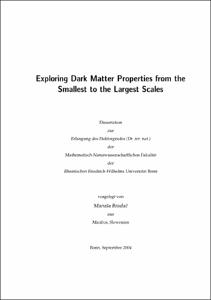Exploring Dark Matter Properties from the Smallest to the Largest Scales

Exploring Dark Matter Properties from the Smallest to the Largest Scales

| dc.contributor.advisor | Schneider, Peter | |
| dc.contributor.author | Bradač, Maruša | |
| dc.date.accessioned | 2020-04-06T21:28:45Z | |
| dc.date.available | 2020-04-06T21:28:45Z | |
| dc.date.issued | 2004 | |
| dc.identifier.uri | https://hdl.handle.net/20.500.11811/2092 | |
| dc.description.abstract | One of the main problems in cosmology is to understand the formation and evolution of galaxies, galaxy clusters, and large-scale structure. Whereas the basics of the current Cold Dark Matter (CDM) paradigm for structure formation are widely accepted, some controversial issues for CDM (e.g. cuspiness of dark-matter halos, substructure crisis) still remain. In order to test CDM predictions, one needs to investigate bound objects from the smallest (dwarf galaxies) to the largest (galaxy clusters) scales at different redshifts. In particular, their matter-content, luminous and dark, has to be studied in detail. We address these issues by using gravitational lensing. Specifically, we explore the properties of mass-substructure and the mass-profiles of galaxies, as well as the mass-profiles of galaxy clusters, using strong and weak gravitational lensing. In the beginning we give a short preface to the subject, intended for a non-expert reader. Following the general introduction to gravitational lensing we address the lens properties of quadruply imaged systems, lensed by numerically simulated galaxies. We focus on the substructure in the lens galaxies. We compare signatures of substructure on gravitational lensing properties and compare these with the observed lensed systems. The second part of this work deals with clusters of galaxies. We describe a method that improves the mass estimates of clusters considerably and develop a new cluster mass reconstruction technique which combines strong and weak lensing. We test our method using simulations and find that it can very successfully reconstruct both the enclosed mass and the mass distribution of a cluster. Finally we apply this technique to an observed cluster RX J1347-1145, the most X-ray luminous cluster. | en |
| dc.language.iso | eng | |
| dc.rights | In Copyright | |
| dc.rights.uri | http://rightsstatements.org/vocab/InC/1.0/ | |
| dc.subject | Kosmologie | |
| dc.subject | Dunkle Materie | |
| dc.subject | Galaxien | |
| dc.subject | Galaxienhaufen | |
| dc.subject | Gravitationslinseneffekt | |
| dc.subject | cosmology | |
| dc.subject | dark matter | |
| dc.subject | galaxies | |
| dc.subject | galaxy clusters | |
| dc.subject | gravitational lensing | |
| dc.subject.ddc | 520 Astronomie, Kartografie | |
| dc.title | Exploring Dark Matter Properties from the Smallest to the Largest Scales | |
| dc.type | Dissertation oder Habilitation | |
| dc.publisher.name | Universitäts- und Landesbibliothek Bonn | |
| dc.publisher.location | Bonn | |
| dc.rights.accessRights | openAccess | |
| dc.identifier.urn | https://nbn-resolving.org/urn:nbn:de:hbz:5N-04333 | |
| ulbbn.pubtype | Erstveröffentlichung | |
| ulbbnediss.affiliation.name | Rheinische Friedrich-Wilhelms-Universität Bonn | |
| ulbbnediss.affiliation.location | Bonn | |
| ulbbnediss.thesis.level | Dissertation | |
| ulbbnediss.dissID | 433 | |
| ulbbnediss.date.accepted | 03.11.2004 | |
| ulbbnediss.fakultaet | Mathematisch-Naturwissenschaftliche Fakultät | |
| dc.contributor.coReferee | Kroupa, Pavel |
Files in this item
This item appears in the following Collection(s)
-
E-Dissertationen (4400)




